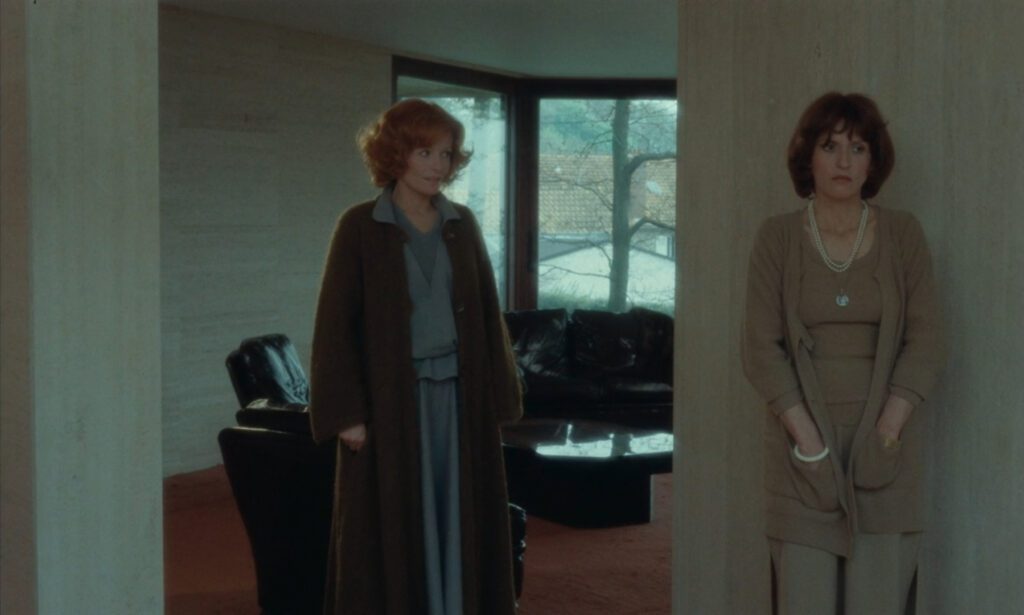
Baxter, Véra Baxter
1977, directed by Marguerite Duras
A name in a Marguerite Duras film holds a mysterious power. Nathalie Granger, Anne-Marie Stretter, Véra Baxter… each is more than just a name. The three rhyme with each other, the “-er” blurring their nationality, none of them unambiguously French. Nathalie Granger is an enigmatic title: why name a film after a child in a supporting role? Madame Stretter’s name is whispered in India Song as an object of fear, and her maiden name, which the vice-consul so hauntingly cries in the streets of Calcutta, is significant enough to give the title to Duras’ subsequent film, Son nom de Venise dans Calcutta désert. When Delphine Seyrig pronounces Véra Baxter’s name in the hotel bar, the words magically ignite the continuous musical theme that overlays the rest of the film (minus a single interruption during a cut to Chantilly). In the climactic revelation we learn that Véra Baxter’s name has indeed sparked Seyrig’s imagination, giving her reason to pay a visit.
Delphine Seyrig, on the other hand, has no name in Baxter, Véra Baxter. Like Gérard Depardieu’s unnamed washing machine salesman in Nathalie Granger or Michael Lonsdale’s unnamed vice-consul of Lahore in India Song, she walks unbidden into the house midway through the film, bringing narrative weight to a scenario heretofore fragmentary, abstract, and mystifying. If the viewer is put off by Duras’ opacity, at least it’s easy enough to laugh at Depardieu’s bumbling salesman or feel pity for Lonsdale’s disgraced diplomat. Unlike the characters around them, their motives are clear.
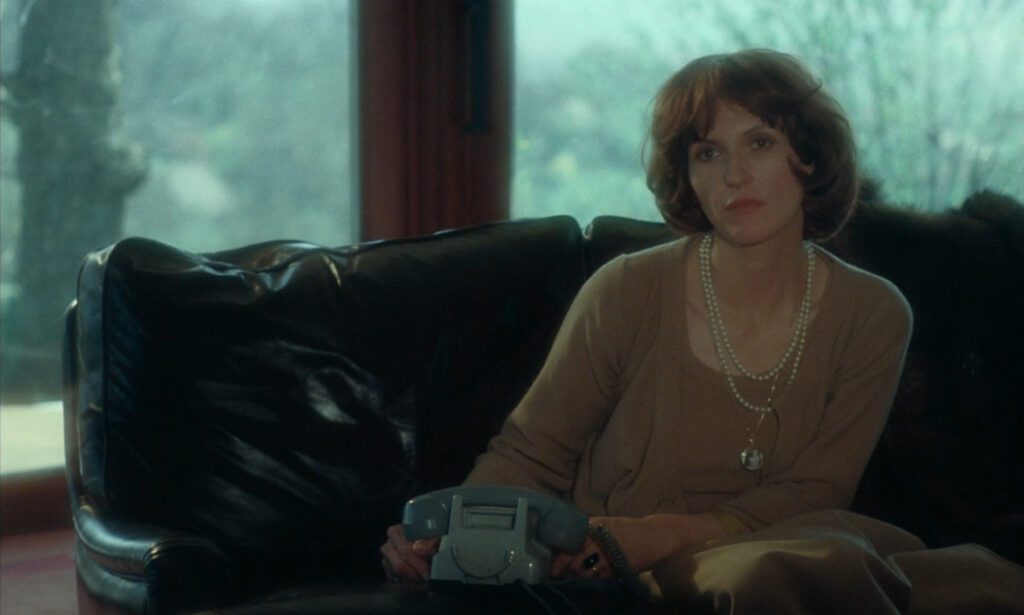
Seyrig, however, hides her motive until the last minutes when she tells Véra Baxter that her name coincides with that of a crusader’s wife burned as a witch:
“It was a thousand years ago. Not here – in those forests, on the shore of the Atlantic, there were women. Their husbands were away, almost all the time. The Holy War, the Crusades. They would be alone for months, in their huts, in the middle of the forest, waiting. And that’s how they started to talk to the trees, the sea, to the animals of the forest.”
This medieval witch is an odd contrast to the modern housewife who shares her name – until we notice their similarities. Both are neglected by itinerant husbands, left to vacant and solitary domestic lives. The living Véra Baxter is not threatened with the stake, but her life is so meaningless that she is driven to the verge of suicide, much like Anne-Marie Stretter in India Song.
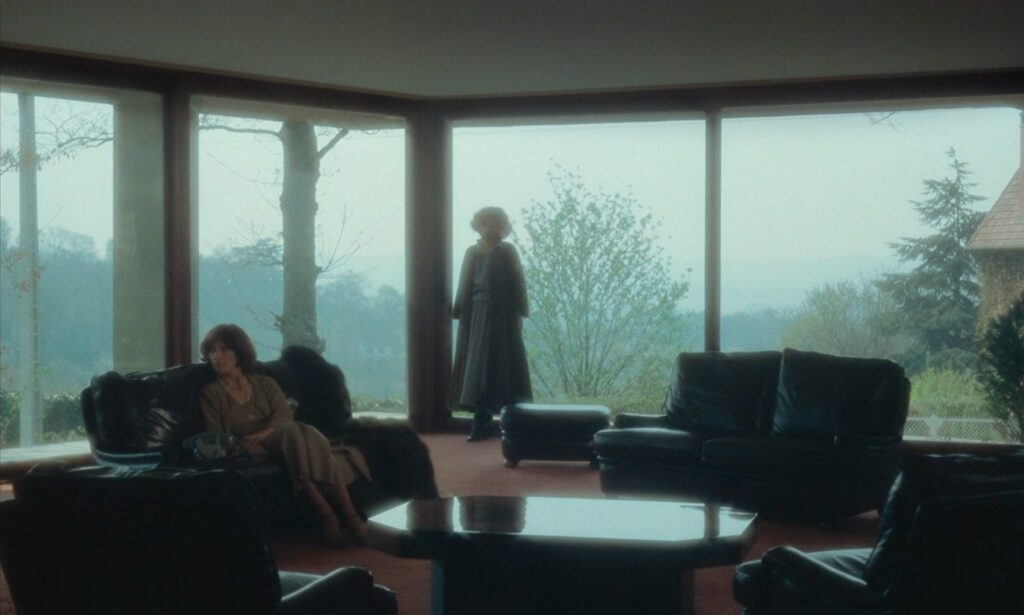
It would be too prosaic to imagine Seyrig a mere busybody, drawn to Baxter by historical curiosity then bonded to her by friendly concern. There’s something uncanny about her character. The movie starts to come alive if we suppose, instead, that Seyrig is none other than the wandering spirit of the old Véra Baxter visiting and rescuing her modern equivalent. Why else should the movie take such care to hide Seyrig’s identity? Why else would she take such an interest in Véra Baxter? How else should we accept her intimate knowledge of the medieval Véra Baxter’s life and circumstances? If there are two Véra Baxters then there’s good reason for the name to appear twice in the title.
We should pay close attention to the ways Seyrig is introduced. She has the first line of dialogue, an offscreen voice asking the bartender about the villa Jean Baxter has just rented in Thionville. She remains offscreen until the crucial moment when she echoes the bartender, incanting the movie’s title and triggering the ceaseless music – as if the music itself were a physical manifestation of her interest in the other Véra Baxter. But the most telling cut in the whole film is the one that precedes her second introduction, halfway through the film, when she first appears in the villa. This appearance, as transgressive as Depardieu’s in Nathalie Granger, follows an unexplained interlude during Véra’s phone call with her husband, in which the camera explores the ruins of a Romanesque church. This cut from the ruins to the modern house transports us across nearly 900 years of architecture, as if Seyrig’s character were magically materializing from the age of the Crusades into the present. Its leap across the centuries recalls the famous cut in 2001: A Space Odyssey bridging prehistoric hominids and the Space Age. But that is not all. During the final shots of the church Véra confesses her wish for suicide, and her voice drops off. Then, as her husband whispers her name twice, the camera rises through the ruins, up to the bell tower and the open sky. This rising motion through the sacred space, and the voicing of her name, form a cinematic prayer in Véra Baxter’s moment of anguish, summoning the older Véra Baxter, who appears immediately in the next shot – answering the prayer.
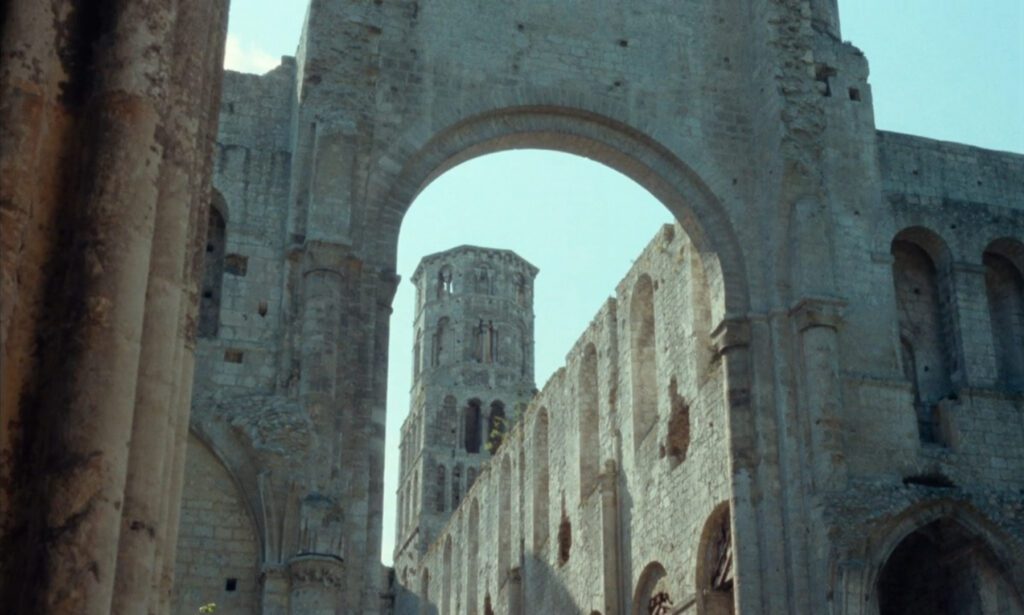
It’s ironic that the modern Véra Baxter, liberated from the oppressive censure of medieval witch hunts, is still punished for her husband’s faults, as if centuries of progress had bestowed little actual benefit on women. There’s a social critique in this implication, but Seyrig also shows Véra Baxter a way out of her malaise. If the modern woman has gained something, however negligible, in her liberation, she has also lost something – she no longer possesses the witchcraft that gave meaning and remedy to her forebear’s loneliness. The Crusaders’ wives had learned to talk to the trees, to the sea, to the animals of the forest, but the modern woman is cut off from nature. Véra Baxter looks out at the trees and landscape through a wall of plate glass windows. She regards the parks of Thionville as terrifying. She’s introduced in the opening credits lying listlessly in bed, unresponsive to the natural sounds of waves and seagulls around her.
The notion of witchcraft in Baxter, Véra Baxter is certainly anachronistic. Medieval witch trials were concerned with demonic Sabbaths, killing animals, and bewitching people, not nature worship or talking to trees. Assuming the film is set around the 1970s, its placement of the Crusades is about 200 years off, and witch burnings did not become commonplace until the 15th century. But Duras is fashioning an imaginary Middle Ages here, no less than the imaginary Bengal of India Song. The difference between history and reality points to the film’s intention: modern life inevitably suffers when disconnected from nature. After Seyrig’s speech about witches, Véra Baxter begins to right herself quickly – having been suicidal minutes earlier, she first says she no longer knows what she wants, and in her last line she’s thinking of accompanying her husband to the Balearics, where she would be surrounded by nature.
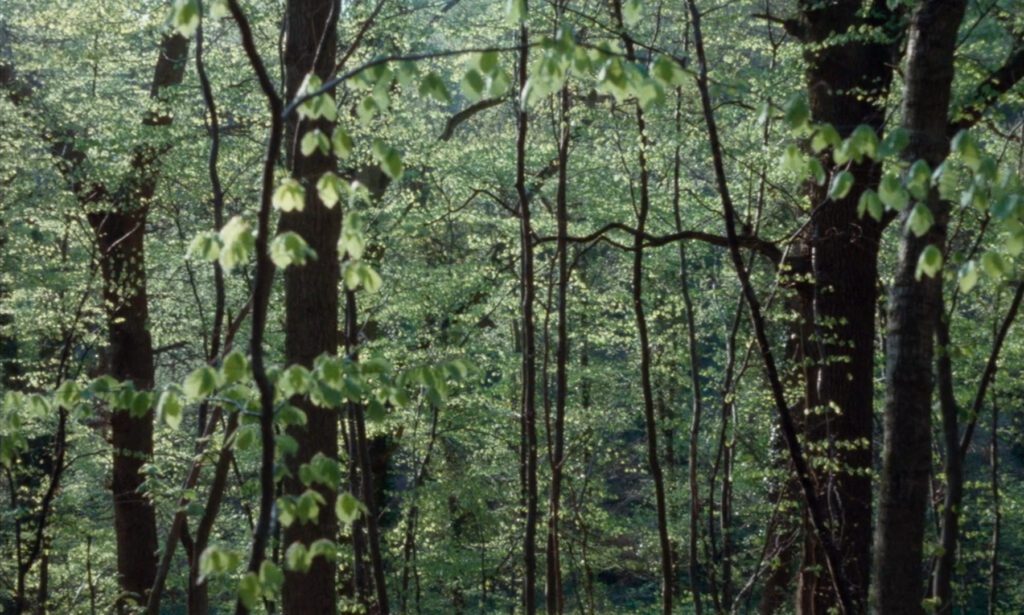
One of Marguerite Duras’ signature methods is to construct elaborate webs of metaphor, building equivalencies between disparate characters, settings, and ideas. Seemingly incidental details link to each other across a film in unexpected ways. Her apparently minimalist scenarios are in fact dense forests of connected thoughts, inviting all sorts of comparisons. Thus the medieval and modern Véra Baxters reflect and contrast with each other, and in similar ways Véra Baxter is equivalent to the other women her husband uses, Monique Combes and the model in Chantilly, linked to Véra by an identical light blue telephone. The inland city of Thionville, near the Luxembourg border, is joined mysteriously to the oceanside resort, unnamed in this movie but resembling the fictional town of S. Thala in Duras’ other films. Just as Véra Baxter echoes the Crusader’s wife who shares her name, her story likewise echoes that of the Jacquements, the villa’s landlords, around whom there are rumors of tragedy in the same house – the wife may have either killed herself or been murdered. In Baxter’s case suicide and murder would be nearly equivalent, considering her husband’s share in the guilt.
There’s also a strange equivalence between Véra Baxter and the villa itself. In the opening lines we’re told that the house bears a woman’s name. It’s modern like she is, and its sparse furnishings correspond to the emptiness of her life. Her husband has paid a million francs to rent the villa, just as he’s paid Michel Cayre the same price to have an affair with his wife. The house corresponds also to the medieval house of the other Véra Baxter, the modern one surrounded by parks and trees like the older one in the middle of a forest. The movie is filled with reminders of surrounding nature, including the seaside, a flock of gulls dancing to the music in mid-air, and a minute-and-a-half panorama of a dense forest. Even the villa contains the four basic elements of nature: an indoor pool (water), a fireplace (fire), a bed of plants in the foyer (earth), and an ocular skylight (air).
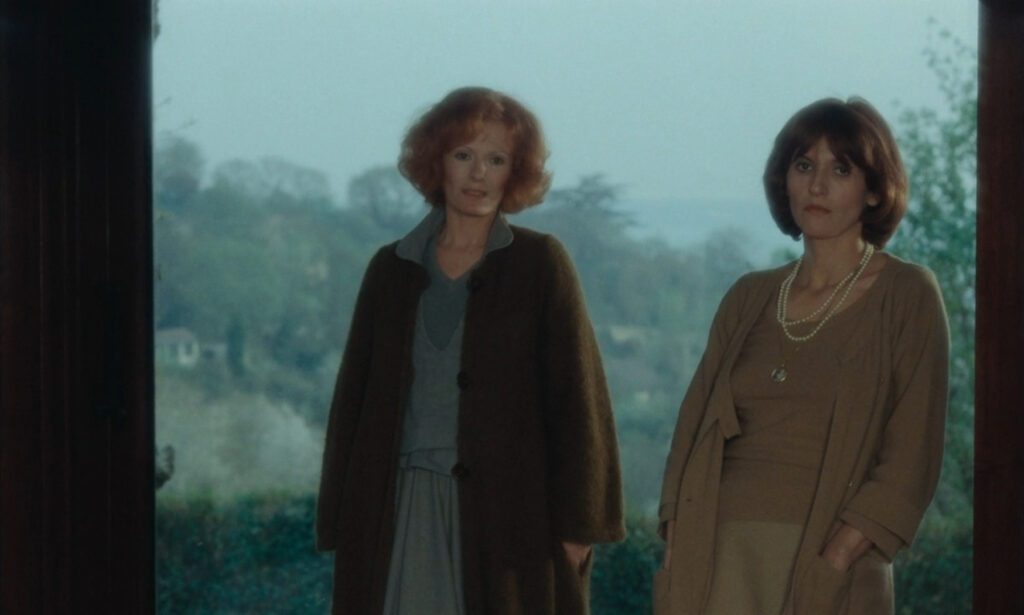
Duras’ purpose, in all of her films, is the same as Seyrig’s purpose in visiting Véra Baxter. By reconnecting Baxter to nature, to the magic of witchcraft, Seyrig reminds her to view the world with the freshness and wonder that is a prerequisite to a meaningful life. By drawing us into the marvelous puzzles of her films, where each offhand detail leads to something larger that we must actively discover, Duras teaches us to look at life with wonder, to reverse the modern habit of shrugging things off as trivial. The first line in her 1979 film Le navire Night is “I told you you must see.” Duras’ project overlaps Antonioni’s – both filmmakers want above all to remedy the malaise of modern life by intensifying our vision, by teaching us to find wonder – not in the dramatic, but in the small things of everyday life.
CONNECTIONS:
2001: A Space Odyssey – Cut spanning centuries of history
Nathalie Granger – Nameless character who enters the house uninvited and adds narrative weight to the fragmentary story
India Song – Nameless character who enters the house uninvited and adds narrative weight to the fragmentary story; contrast and equivalence between a modern suicidal housewife and another woman from far away or long ago